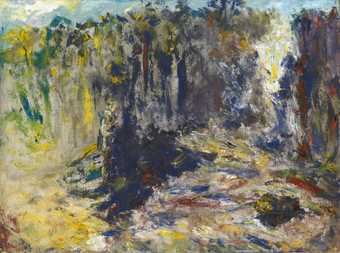It is as a draughtsman that Jack B Yeats first won fame and his drawing has always retained the magically tender charm that it had at the beginning. But even in his earliest tinted drawings he revealed a lovely colour sense and a highly sensitive feeling for colour harmonies that he must be ranked as one of the greatest colourists in the whole history of painting.
One of the earliest pictures in the exhibition is called A Westerly Wind. It recalls a day when, as the artist reached the river at O’Connell Bridge in Dublin, the wind changed. The atmosphere has suddenly become transfigured and the fair-haired child, alert on the outside-car on the quay, seems in his eager youth like the divine herald of a kinder dispensation. In The Dark Bathe the splendour of the struggle between day and oncoming night is awe-inspiring. Sea and sky are already dark. But a man has faith in creation and immerses himself in the splendour in the sea. Again in the Heroes the Flames there is danger, but the men who face the danger take on a splendour that outmatches the splendour of the unchained natural element.
Yeats has always loved horses and in A Lift On The Long Car, in Here Comes The Chestnut Mare, in Among Horses, in The Path Of Diarmuid and Grainne and half a dozen other pictures we may realise the incomparable mastery with which he can capture their fine articulations, their nervous grace, their spirit.
He has always loved the theatre too, delighting in the colour and excitement of the ‘transformation’ scene as in Wey Hey, there she Rises, or speculating with imaginative sympathy on the destinies of the play actors in the small masterpiece, Drama.
Thomas MacGreevy


